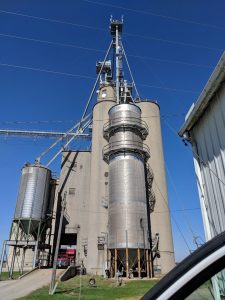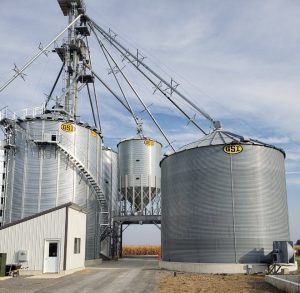Agronomy, Grain Marketing, Homepage Slider, Soybean Quality
Rain Delays and Storage Space, Communication and Patience
By Dusty Sonnenberg, CCA, Ohio Field Leader: a project of the Ohio Soybean Council and soybean checkoff.
Harvest delays caused by rain may seem like an inconvenience to many, however it has been a welcome opportunity for many commercial grain facilities to relieve some storage pressure and ship grain out during what began as a busy and bountiful fall harvest.
The 2021 harvest season began with a wide range of early yield reports. Many areas in Ohio are experiencing above average yields in both soybeans and corn. Large yields can lead to long lines and reduced storage capacity at local cooperatives and commercial grain elevators.
Grain facilities with access to rail are at an advantage over those dependent on trucking out all the grain according to Clark Carroll, General Manager of the Gerald Grain Center. Those facilities with rail access can also have difficulty. “The challenge the facilities with rail access can face is the availability and timeliness of train schedules,” said Carroll. Another factor that impacts truck-based grain elevators is the proximity of their grain facilities to the ports on Lake Erie and the Ohio River and the freighter or barge traffic once those facilities get full.
Farmers with on-farm storage have options when planning out their harvest, which is an advantage over those without on-farm storage. Some farmers will fill their on-farm storage first, and then haul the rest to the elevator once their bins are full. Others will deliver to town first based on their yield estimates, and then utilize the on-farm storage later in the season when there is a greater risk of commercial facilities being closed for periods of time until room can be made. Still others will do a combination throughout the season, hauling to the elevators during the day, and then utilizing on-farm storage after-hours when the elevators are closed. Regardless of the scenario, it is good to have a plan says Tom Norden of the Grelton Elevator. “If the yields continue to be this good, and there are not weather breaks to move gain out, some facilities will fill up.”
There are several factors to consider when deciding if grain should be delivered directly to the elevator or stored-on farm at harvest. For those that have fall harvest contracts, the delivery period will be a consideration. Traditionally on-farm storage is utilized to take advantage of carry in the market. Another factor to consider is the quality and moisture of the grain at harvest. For those with drying systems, grain at higher harvest moisture levels can be harvested, dried and stored on-farm. For those only with aeration systems in the on-farm storage, maintaining grain quality can become a concern. The storage of slightly higher moisture grain can pose a challenge depending on the weather, temperature and humidity.
Traditionally on-farm storage is utilized to take advantage of carry in the market. Another factor to consider is the quality and moisture of the grain at harvest. For those with drying systems, grain at higher harvest moisture levels can be harvested, dried and stored on-farm. For those only with aeration systems in the on-farm storage, maintaining grain quality can become a concern. The storage of slightly higher moisture grain can pose a challenge depending on the weather, temperature and humidity.
“Once grain is put in a bin, the quality will not improve,” said Curtis Young, OSU Extension Educator. “The goal is to maintain the quality until such time it is delivered.” Farmers utilizing on-farm storage must ensure the quality of the grain is maintained throughout the storage period, which means proper sanitation and fumigation of the bins prior to use, and monitoring the grain quality throughout the storage period. Insect infestations and spoilage from high moisture can quickly cause grain quality to deteriorate in a bin if it is not monitored.
Communication and patience during harvest are always a key. Communicating with the local commercial grain facilities to monitor their storage capacity status throughout the season is always recommended. This is beneficial to both the farmers and elevator managers. Having patience goes without saying.